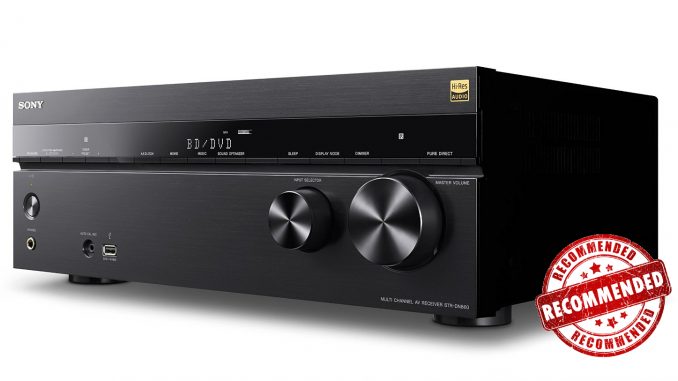
Sony's Budget Excellence
Sony may not have made many changes in terms of design on their new generation of AV receivers, but you will find some big improvements if you look under the hood. In order to stay on top of the class, the new STR-DN860 provides 4K upscaling, support for DSD and, most importantly, a very good sound quality.
Sony STR-DN860
-
Sound Quality - 95%95%
-
Features - 85%85%
-
Ease of Use - 88%88%
-
Build Quality - 85%85%
SUMMARY
Thanks to the excellent sound quality, user-friendly interface and a number of secondary features and options, the Sony STR-DN860 is nothing less than a great choice.
Great dynamic and detailed sound.
Great user interface and applications.
No support for DSD over the network.
No support for Atmos (so far).
Like most well-known manufacturers, Sony is trying to give their AV receivers a distinctive look that will make them stand out from the crowd. However, when it comes to AV receivers in the lower price classes there´s limited possibility for design experiments and the real difference comes down to the details.
The front of the STR-DN860 is separated in two sections by a horizontal line. On the upper half, Sony uses a somewhat smaller OSD, which is covered by what I assume is a transparent plastic surface that extends the entire width of the front panel. The lower part is relatively clean and contains two control wheels to the right - to adjust the volume and source selection, while on the left you´ll find the standby button, a 6.35mm gold-plated headphone output, a microphone input for calibration and USB-A port.
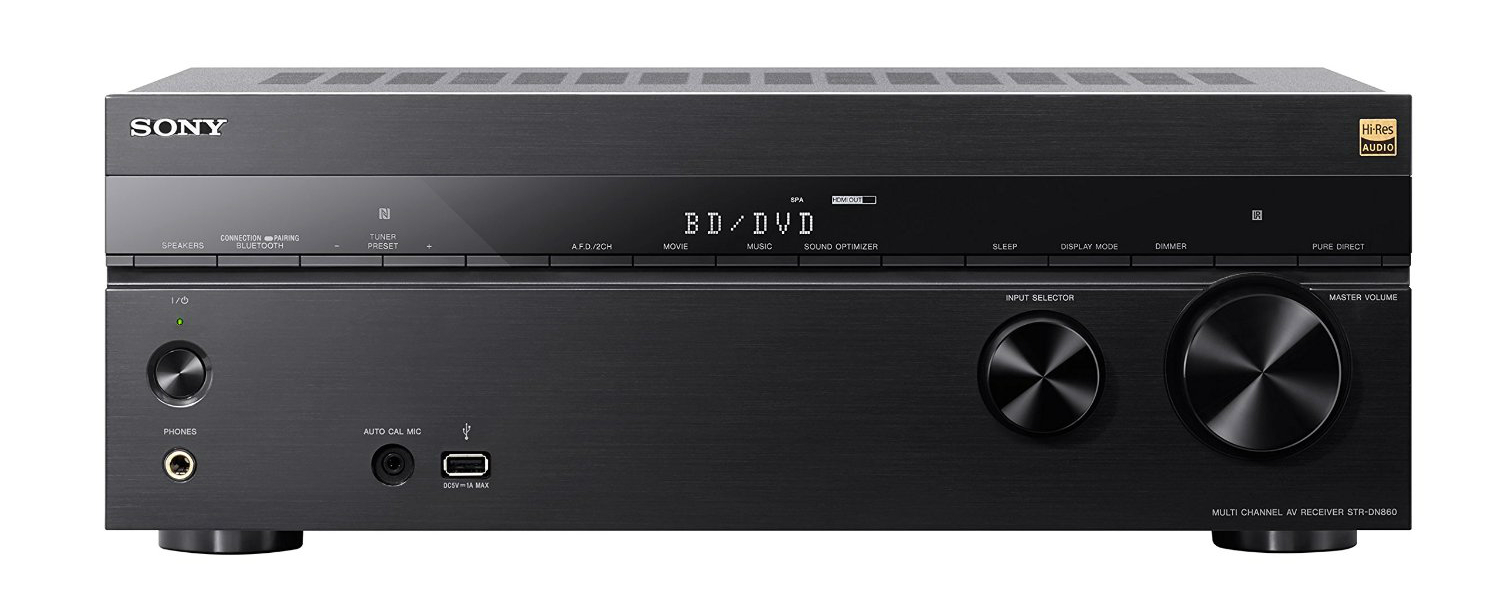
The horizontal line below the OSD holds 12 discrete buttons used to control the most important functions. The very top of the front panel is reserved for the Sony logo on the left side, and a 'Hi-Res Audio' badge on the right, indicating that the receiver is able to play high resolution audio formats.
The top and sides are made from a single piece of sheet metal, with a large number of slots for cooling, while the rear panel follows the general trend of reducing the number of analog inputs in favor of digital and network connectivity. Analog inputs are reduced to four pairs of RCA inputs, with two composite video inputs and one output. There are five HDMI inputs, one of which is HDCP 2.2, and two that are mainly intended for an audio-signal from a SACD or Blu-ray player.
In addition, there are two optical and one coaxial digital input, as well as a FM antenna connector. Network connection can be made via the Ethernet port (RJ45) or wirelessly using the provided two Wi-Fi antennas. Loudspeakers are connected via standard terminals that accept bare wire, forks or banana plugs, and there are two outputs for active subwoofers.
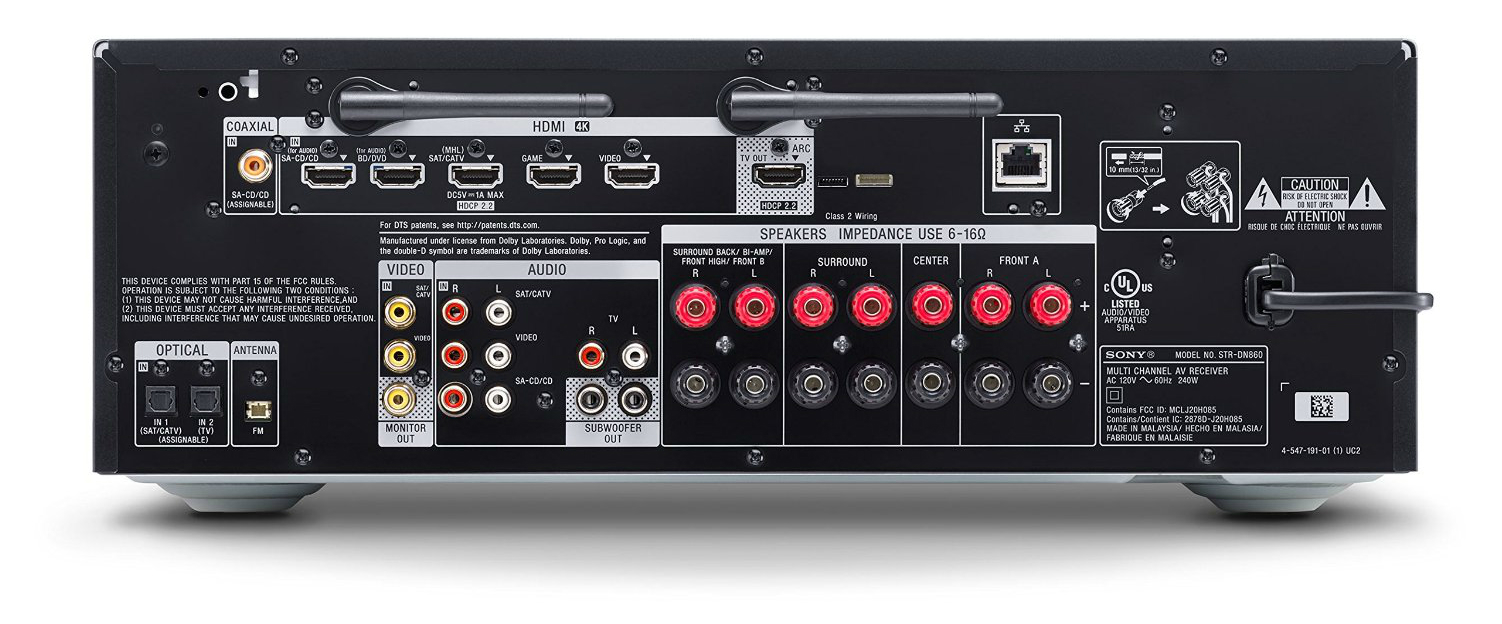
The interior of the receiver has a pretty classic layout, but is due to a less deep housing filled to its fullest. In the front are some large cooling fins, followed by seven pairs of complementary output transistors (Sanken MN2488 and MP1620). The last half is occupied by a two level printed circuit board, along with several smaller ones.
Sony uses a completely new design for the preamplifiers, which I guess was necessary to adapt to high resolution material. The new preamplifier has a faster response, better signal-to-noise ratio (SNR), reduced thermal interference and greater stability thanks to its own separate cooling.
On the lower board are two electrolytic capacitors from Nippon Chemi-Con with 6,800 microfarad capacity each, while the left part is reserved for the transformer and power supply section. Another interesting thing is the section for the wireless networking, which is housed in a fully shielded compartment in order to prevent interference. This is a really smart solution that is rarely found, even in much more expensive receivers.
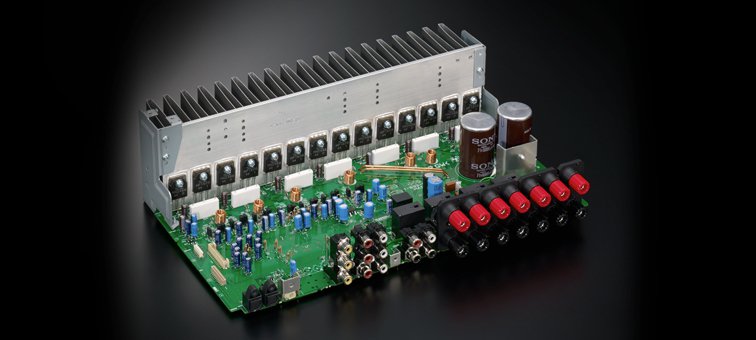
Ready For Any Occasion... Almost
One thing I liked while testing the STR-DN860 was the slightly smaller remote control, which due to its dimensions is equipped with a smaller number of buttons compared to what you´re normally used to. This is only a logical step I guess, as controlling the receiver can be performed by using a free Android / iOS app on a bluetooth device like a phone or tablet. Sony's application is called SongPal and is currently in its third version with an updated design, and comes with a high degree of control of the receiver. This includes the selection of sources, access to shared audio files over the network, controlling the playback and network services (Pandora, Spotify, AirPlay, etc.), but also additional features such as equalizer settings and so on.
While watching movies, the Sony STR-DN860 provided a dynamic sound with an abundance of detail, which is one of the more important aspects when it comes to recreating the atmosphere that accompanies any given movie scene. Three-dimensional effects are recreated faithfully and are precisely placed, and the details and changes in texture and volume are presented very well. In addition, the STR-DN860 does an excellent job with rapid changes in volume and macro-dynamics, and in this respect it is almost on par with a lot more expensive AV receivers. This indicates that there is no significant lack in power when needed.
The 860 provides 95 watts to each of the seven channels at 6 ohms, and the possibility of hooking up two active subwoofer should be enough for surround systems of smaller and medium size. The only disadvantage is reflected in the lack of decoders for the new surround sound formats like Dolby Atmos, DTS: X and Auro-3D, which many competing receivers already have, but we expect Sony to include this in any new firmware update in the near future.
Switching to music in two-channel format gives the 860 a sense of even more power, resulting in better dynamics and a fuller and more powerful bass. The sound is refined and pleasant to listen to, and the soundstage is very well defined in both width and depth. The high and mid frequencies are open and direct, with a clear presentation and full of fine detail. Musicality and rhythm are also present during more complicated and difficult music, making the STR-DN860 a truly versatile AV receiver.
In addition to the lack of decoding any newer surround sound formats, is a lack of support for DSD audio, which can be played via USB memory, but not over the network. We assume that Sony will resolve this by updating the firmware as these are pretty important functions. Until then, the STR-DN860 limits the playback over the network to 192 kHz / 24-Bit FLAC and WAV, 96 kHz / 24-Bit ALAC and other popular formats.
However, Sony has done a great job with the multilingual user interface, which is intuitively designed, easy to use and visually appealing thanks to helpful illustrations and graphics. Automatic calibration is also extremely simple to do and takes less than a minute, but the enthusiasts may want to engage in more detailed settings of all the parameters at their own discretion. Although it may already be implied, it should be noted that the STR-DN860 supports 4K Ultra HD and enables upscaling HD content to this resolution.
Conclusion
Despite facing some fierce competition in this specific price class, the Sony STR-DN860 has too many aces up its sleeve to be considered defeated. Thanks to the excellent sound quality, user-friendly interface and a number of secondary features and options, this receiver is nothing less than a great choice. It really only lack a couple of things - support for Immersive Sound and DSD over the network - something Sony probably will fix very soon.
GET IT ON eBay!
- FEATURES
- SPecIFICATIONS
- IN ThE bOX
• 7.2 Ch. 1050W A/V Receiver (150 W x 7 @ 6 ohms, 1 kHz, THD 0.9%)
• Solid circuitry and structure deliver dependable audio performance
• 5-in/1-out HDMI® flexibility with HDCP 2.2 support (1-in/1- out)
• Dual-band Wi-Fi®1 for Airplay®, DLNA6 , and Google™ Cast for Audio
• Google™ Cast for Audio5 for easy streaming of your favorite music apps
• Expand your listening with powerful multi-room capability with SongPAL Link
• Stream music from receiver to compatible Bluetooth headphones
• Supports Hi-Res audio (incl. DSD) playback via LAN, Wi-Fi, HDMI®, and USB
• Enhanced setup and usability via rich GUI and streamlined remote
• Turn your smartphone into a remote control with free SongPal app
• LDAC™ for an optimized Bluetooth® audio streaming experience
• DSEE HX upscales USB, LAN, and streaming audio to near Hi-Res quality
• Pure Direct audio mode for a noise-free, audio signal path
• Connect your smartphone via HDMI with Mobile HighDefinition Link (MHL)
• Standby Audio/Video pass-through for HDMI® connected devices
• Enjoy rich, dynamic sound at any volume level with Sound Optimizer
• Instantly play music from mobile device with Wake from standby
• HD Digital Cinema Sound™ with Front-High speaker output
• Experience memorable performances with Sony Sound Field Technology
• One touch power, play, and system control w/ BRAVIA® Sync
• Dedicated LAN input for Custom Install Services IP Control support
• Supports 4K upscaling6 and pass-through with support for 60p, 4K content
• Share personal audio/video content on the big-screen via Miracast
• HDMI® out w/ 24p12, Deep Color, and TRILUMINOS™ Color pass through support
• Front USB 2.0 input device charging and playback
• Advanced Digital Cinema Audio Calibration for quick Set-Up
• Dolby® TrueHD, Pro logic II, IIx and dts® HD Enhanced Audio Codecs
• Dual IR repeaters (1-in, 1-out) for external device control
• Enjoy personal, 4K smartphone content via MHL 3.0 connectivity (x2)

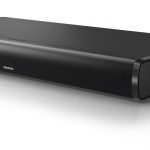
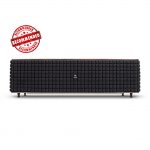
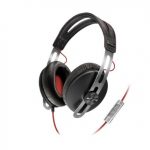
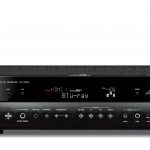
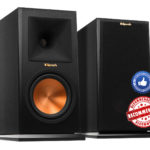
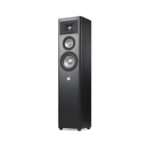
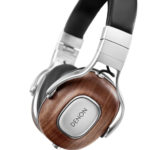
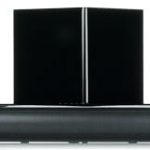
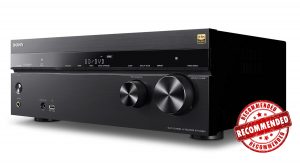


It’s a really nice receiver, unfortunately had to return it as wouldn’t play Googlecast WiFi music controlled by the Android Songpal app. Sony support Australia said I needed to buy a Google Chromecast and plug that into the receiver to get multiroom working… So returned it and got a Chromecast audio to plug into my two year old STR-DN1040. Bought another couple of SRS-X77’S instead to bring the total to four which are fantastic devices.
I’m surprised a receiver of this quality has no FM co-ax inlet. I’m in a poor signal area and need to use mt rooftop antenna.